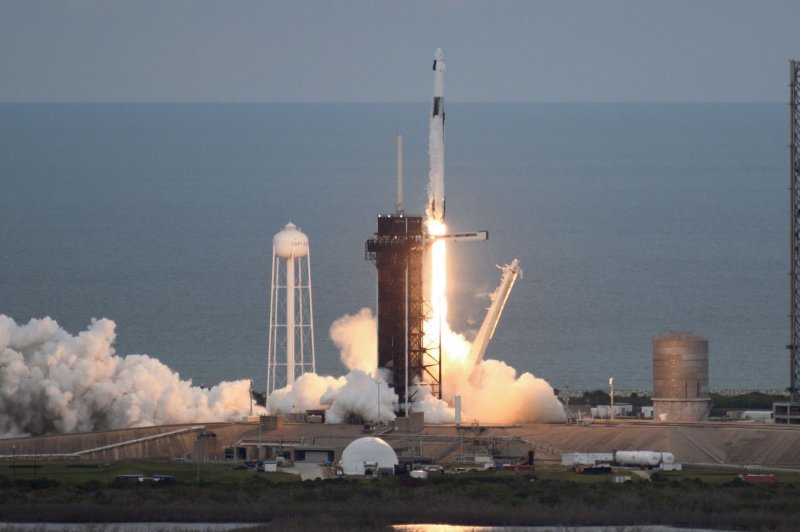1 of 5 | A SpaceX Falcon 9 rocket launches the Axiom Mission 2 crew to the International Space Station at 5:37 p.m. Sunday from Complex 39A at Kennedy Space Center in Florida. Photo by Joe Marino/UPI |
License Photo
CAPE CANAVERAL, Fla., May 21 (UPI) -- A four-member crew lifted off aboard a SpaceX Falcon 9 rocket late Sunday afternoon from Kennedy Space Center in Florida for an eight-day visit to the International Space Station.
The Orion capsule in which the crew is riding, named Freedom, is expected to dock with the floating laboratory at 9:24 a.m. Monday.
The brand-new rocket soared into space on time at 5:37 p.m. from Florida's Kennedy Space Center's Complex 39A into partially cloudy skies to start circling Earth some 9 minutes later.
The rocket's reusable first-stage came down as planned less than 8 minutes after liftoff in a landing zone at Cape Canaveral Space Force Station, which is adjacent to the space center.
Controllers confirmed "good orbital insertion" just over 9 minutes after launch, and the capsule separated from the rocket's second stage a little over 12 minutes into the flight as the astronauts headed toward a rendezvous and docking with the space station.
Launch spectators were expected to hear a sonic boom a few minutes after liftoff as the first-stage booster headed back to Earth for a touchdown in Landing Zone 1 at Cape Canaveral Space Force Station rather than the usual drone ship in the ocean.
SpaceX said it would take advantage of "extra performance" by having the 126-foot booster come down on land. Company officials said this reduces the need to have a recovery crew stationed on a drone ship, and it also speeds turnaround of rockets for a later mission.
The trip is being conducted by Houston-based Axiom Space, which is operating its second private astronaut mission, called Ax-2, in a contractual deal with NASA.
Once in orbit, the spacecraft will start chasing the space station for the docking. They crew is to return with a splashdown in the Atlantic Ocean or Gulf of Mexico at a site to be determined largely by the weather.
The commander and pilot for this mission, Peggy Whitson and John Shoffner, respectively, are U.S. citizens and Axiom Space employees, while mission specialists Ali Alqarni and Rayyanah Barnawi are from Saudi Arabia.
They will have nearly full access to the space station and to visit with those already aboard, including Russian cosmonauts Sergey Prokopyev and Dmitri Petelin, NASA officials said. Prokopyev and Petelin have been on the space station since Feb. 26.
Only a few -- yet imperative -- safety exceptions will apply to setting off-limits areas, said Whitson, a former NASA astronaut and veteran of three of space shuttle and space station missions.
The Axiom 2 crew will carry out experiments and research spanning from the science of materials to biology and production of enhanced medications, the crew said during a press conference Tuesday.
Mission specialist Barnawi is a biologist and breast cancer researcher, and now the first Saudi woman in space. She will be joined in her work by Alqarni, a Saudi air force fighter pilot.
Barnawi will keep on working on the same research project she started in collaboration with 20 colleagues in Saudi Arabia.
Research includes creating nanomaterials -- substances needed in cartilage repair therapies. That's possible only by working in the near-zero gravity environment.
To prepare for future activities, the Axiom crew will compile production standards and procedures, too.
And there will be academic activities meant to raise students' interest in engineering, Alqarni said. That is all part of the science, technology, engineering and mathematics disciplines, known as STEM.
In Saudi Arabia, schoolchildren will take part in live video events.
One project will provide "a huge opportunity to study how a kite can work and behave in space," Alqarni said. That involves learning about the behavior of different kite shapes on the space station.
Students across Saudi Arabia will participate in ground-based experiments to compare data with custom-built kits. The project stems from collaboration with the Saudi Space Commission.
"It will be amazing for the students to compare the results that they had on the ground with the ones we are going to have on the station, Alqarni said."
Participating students from around the world will be able to show their interest, curiosity and abilities in the space journeys they envision. And there will be time for poetry, as well.
Two representatives of each age group will be recognized during live TV broadcasts from orbit. Besides working at an extensive program of Earth photography, Shoffner will host a Space Art Contest among students on the ground, Axiom's website said..
And for this mission, Axiom planners decided to include the arts, too. So, besides working at an extensive program of Earth photography, Shoffner will host a space art contest.
The Axiom mission is being conducted under a new pricing policy for private astronaut missions.
NASA is charging $4.8 million per flight for integration, mission planning and execution and tracking and $5.2 million per flight for crew time on the space station to support visiting vehicle operations, logistical support and familiarization for the visitors.
There are a series of additional fees, as well, including charges for food, at $2,000 a day per person, and trash disposal.















